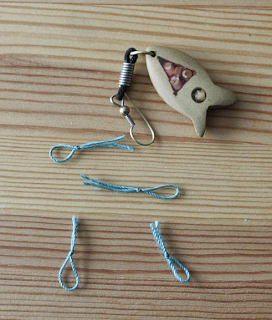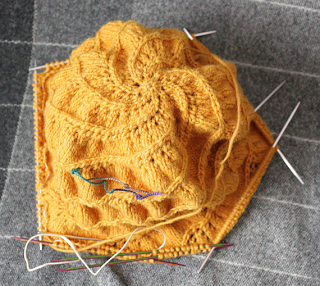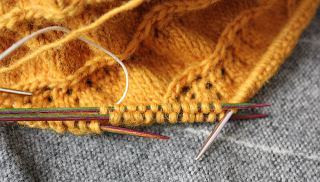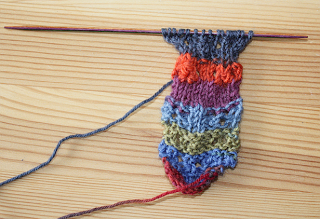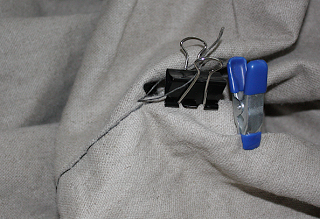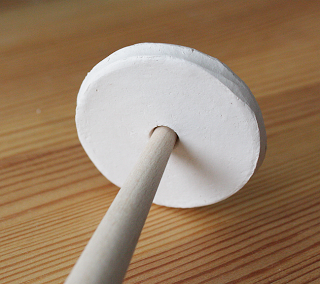I have already mentioned the Vienna wooly week, and I've been busy doing some more spinning during the weekend. Those of you that know my spinning style know that I have a tendency to do thin to very thin threads, and I have my own theory why that might be as it is (which I won't go into today).
Just like with hand-woven fabrics nowadays compared to those hand-woven (naturally, since there were no automatic or semi-automatic looms) in the middle ages, there's this basic difference in "look you aim for". Today, a hand-woven fabric is usually quite coarse (to keep the price in a somewhat affordable range) and slightly uneven on purpose - because that's how you see that it was hand-woven, right? And if you buy a pricey hand-woven textile, you want people to see it is special because it's hand-woven, right again?
The medieval weaver did surely not aim for the modern irregular look, but for as smooth and even as possible. And we have the same phenomenon in spinning. I have actually been told by people that "you'll want to make your thread a bit more irregular, or nobody will see it's hand-spun". Being a good medieval-minded spinner, no, I do not want that. And then there's this yarn thickness problem, too. Most modern hand-spuns are way, way thicker than yarns used in medieval weaves - which makes the fashionable irregularity of yarn thickness possible.
If you spin a thread that, on average, contains 120 fibres at any diameter, you can easily add or omit ten or twenty fibres and still get a reasonably even yarn. If you add or subtract more - I'll just make up some number here, say 50 - you will get an uneven yarn, but one that will still hold up to the weight of the spindle.
If your starting thread contains, on average, only 50 fibres at any diameter, you don't want a thinner bit with twenty fibres less - that will break your thread because it cannot support spindle weight anymore - and you don't want a thicker bit with twenty fibres more, because that will really show up as a slob. Which means the thinner you spin, the more even you have to spin, because every weakness will show up and every slob will too.
Fighting occasionally with my yarn while spinning those deliciously thin threads used in the Hallstatt bands, I have meditated quite a bit about irregularities. Not letting slobs occur will take quite an amount of concentration, and so does not making thin and thus weak spots. I work with a comparatively heavy spindle, since I like to know that each individual thread in the final 2-ply will be strong enough to take some tension.* The thread coming out of that process is insanely strong and elastic compared to a same-thickness plied yarn made of commercial merino wool** and really, really beautiful to behold - but very slow work. Really slow work. I manage to spin about 0,5 grams of fibre in one hour, and that's fibre spun in the grease, and with the accompanying amount of dirt and dust coating each fibre.
Slow work that needs full concentration, meaning I have to be fit, there needs to be good light, and I don't spin for more than two hours at the very most in one day - but it is very satisfying work as well!
*I have spun on light spindles that many people prefer for thin threads, but I don't like the insecurity - I much prefer to have the spindle earn its name from time to time... and don't tell me that you never thought about why it's called a "drop spindle".
** which finally converted me to an absolute lover of old sheep races
Just like with hand-woven fabrics nowadays compared to those hand-woven (naturally, since there were no automatic or semi-automatic looms) in the middle ages, there's this basic difference in "look you aim for". Today, a hand-woven fabric is usually quite coarse (to keep the price in a somewhat affordable range) and slightly uneven on purpose - because that's how you see that it was hand-woven, right? And if you buy a pricey hand-woven textile, you want people to see it is special because it's hand-woven, right again?
The medieval weaver did surely not aim for the modern irregular look, but for as smooth and even as possible. And we have the same phenomenon in spinning. I have actually been told by people that "you'll want to make your thread a bit more irregular, or nobody will see it's hand-spun". Being a good medieval-minded spinner, no, I do not want that. And then there's this yarn thickness problem, too. Most modern hand-spuns are way, way thicker than yarns used in medieval weaves - which makes the fashionable irregularity of yarn thickness possible.
If you spin a thread that, on average, contains 120 fibres at any diameter, you can easily add or omit ten or twenty fibres and still get a reasonably even yarn. If you add or subtract more - I'll just make up some number here, say 50 - you will get an uneven yarn, but one that will still hold up to the weight of the spindle.
If your starting thread contains, on average, only 50 fibres at any diameter, you don't want a thinner bit with twenty fibres less - that will break your thread because it cannot support spindle weight anymore - and you don't want a thicker bit with twenty fibres more, because that will really show up as a slob. Which means the thinner you spin, the more even you have to spin, because every weakness will show up and every slob will too.
Fighting occasionally with my yarn while spinning those deliciously thin threads used in the Hallstatt bands, I have meditated quite a bit about irregularities. Not letting slobs occur will take quite an amount of concentration, and so does not making thin and thus weak spots. I work with a comparatively heavy spindle, since I like to know that each individual thread in the final 2-ply will be strong enough to take some tension.* The thread coming out of that process is insanely strong and elastic compared to a same-thickness plied yarn made of commercial merino wool** and really, really beautiful to behold - but very slow work. Really slow work. I manage to spin about 0,5 grams of fibre in one hour, and that's fibre spun in the grease, and with the accompanying amount of dirt and dust coating each fibre.
Slow work that needs full concentration, meaning I have to be fit, there needs to be good light, and I don't spin for more than two hours at the very most in one day - but it is very satisfying work as well!
*I have spun on light spindles that many people prefer for thin threads, but I don't like the insecurity - I much prefer to have the spindle earn its name from time to time... and don't tell me that you never thought about why it's called a "drop spindle".
** which finally converted me to an absolute lover of old sheep races







